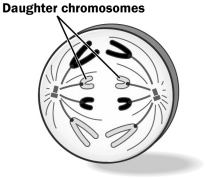Correct Answer

verified
Correct Answer
verified
Short Answer
During mitosis, the number and shape of an organism's chromosomes become obvious. This set of identifiable chromosomes can be arranged into a diagram, or _______, of that organism.
Correct Answer

verified
Correct Answer
verified
True/False
If the skin cell of an organism has 24 chromosomes, its gametes must also have 24 chromosomes.
Correct Answer

verified
Correct Answer
verified
Short Answer
The goal of __________ is to increase genetic diversity by creating a new diploid individual from haploid cells.
Correct Answer

verified
Correct Answer
verified
Short Answer
Huge amounts of DNA (6 feet in humans) can fit into the nucleus of a single cell because the DNA is wrapped around ________ to form a "beaded necklace" know as chromatin.
Correct Answer

verified
Correct Answer
verified
Multiple Choice
If a plant has a karyotype of 18 chromosomes, how many chromosomes would be present in each of its gametes?
A) 36
B) 18
C) 9
D) 6
Correct Answer

verified
Correct Answer
verified
Short Answer
As the _____________ separate during prophase, they determine opposite ends, or spindle poles, of a cell that is beginning mitosis.
Correct Answer

verified
Correct Answer
verified
Multiple Choice
Only meiosis could lead to the production of new
A) skin cells.
B) brain cells.
C) sperm cells.
D) liver cells.
Correct Answer

verified
Correct Answer
verified
Multiple Choice
The parent cell shown below left undergoes meiosis. In the box, lettered A through C, are three different gametes.  Which of these gametes could have come from this parent cell?
Which of these gametes could have come from this parent cell?
A) Gamete A
B) Gamete B
C) Gamete C
D) All of these gametes could have come from this parent cell.
Correct Answer

verified
Correct Answer
verified
True/False
During meiosis I, the microtubules from only one spindle pole attach to only one member of a bivalent.
Correct Answer

verified
Correct Answer
verified
Multiple Choice
When examining the rapidly dividing cells of the onion root tip, you see a cell whose chromosomes are visible and are arranged in approximately the same size and shape as the nucleus. What stage of mitosis is this cell in?
A) metaphase
B) prophase
C) anaphase
D) telophase
Correct Answer

verified
Correct Answer
verified
Multiple Choice
Which set of symbols represents the stages of interphase?
A) G₀, G₁, and G₂
B) S₁, S2, and G₀
C) S, G₀, and G₁
D) S, G₁, and G₂
Correct Answer

verified
Correct Answer
verified
Short Answer
At the end of telophase the cell is ready for physical division into two cells, a process called ___________.
Correct Answer

verified
Correct Answer
verified
Multiple Choice
Adult stem cells differ from embryonic stem cells in that
A) embryonic stem cells are found throughout the body of the fetus, but adult stems cells are found only in adults.
B) adult stem cells are easier to obtain than embryonic stem cells.
C) adult stem cells can differentiate into fewer types of cells than embryonic stem cells.
D) embryonic stem cells do not require differentiation signals like adult stem cells do.
Correct Answer

verified
Correct Answer
verified
Short Answer
The most critical stage of interphase for a cell that needs to undergo cell division is ________ phase. If the cell does not complete this phase, it cannot undergo DNA segregation.
Correct Answer

verified
Correct Answer
verified
Multiple Choice
Why must DNA be packed into chromosomes before mitosis or meiosis can occur?
A) In their unpacked state, the strands of DNA would be difficult to pull apart during cell division.
B) The zygote would be unable to live if the DNA were not packed into chromosomes.
C) We would be unable to see the karyotype if the DNA were not packed into chromosomes.
D) Some of the genes would escape during cell division if they were not packed tightly into chromosomes.
Correct Answer

verified
Correct Answer
verified
Multiple Choice
How many sister chromatids are in a bivalent?
A) 2
B) 4
C) 8
D) 16
Correct Answer

verified
Correct Answer
verified
Multiple Choice
The cell depicted below has a diploid number of 4 (2n = 4) .  Assuming cell division started with a diploid cell, in what stage of what type of cell division is the cell?
Assuming cell division started with a diploid cell, in what stage of what type of cell division is the cell?
A) anaphase of mitosis
B) anaphase I of meiosis
C) anaphase II of meiosis
D) Both A and C are possible.
Correct Answer

verified
Correct Answer
verified
Multiple Choice
The G₀ phase of the cell cycle is distinguished by
A) an active preparation for DNA synthesis.
B) a doubling of chromosomes.
C) an absence of preparation for DNA synthesis.
D) the appearance of a metaphase plate.
Correct Answer

verified
Correct Answer
verified
Multiple Choice
During anaphase I of meiosis,
A) sister chromatids are pulled apart toward opposite poles.
B) each member of a bivalent moves toward a different pole.
C) all bivalents are pulled to the same pole.
D) paired homologues become attached to each other by microtubules.
Correct Answer

verified
Correct Answer
verified
Showing 21 - 40 of 77
Related Exams